Key Points:
- There are 18 different types of snakes in Michigan that occupy different parts of the state depending on what type of habitat they prefer.
- The northern ribbon snake, quite common to Michigan, has black scales on the bottom part of the mouth, and the rest of the mouth is white.
- The copperbelly watersnake is protected in Michigan as its population has been in decline.
Michigan is known for having a huge variety of wildlife. If you’re out hiking, camping, hunting, or having fun doing other outdoor activities you could see rabbits, deer, squirrels, foxes, coyotes, or even wolves. And you also may come across some snakes. Michigan is home to 18 different varieties of snakes. That might seem like a lot of snakes but almost all of the snakes that you would see in Michigan are harmless to humans. There’s only one venomous type of snake in Michigan so your chances of getting hurt by a snake while you are enjoying the beautiful outdoor areas of Michigan are very small.
Non-Venomous Snakes in Michigan
There are 18 different types of snakes in Michigan that occupy different parts of the state depending on what type of habitat they prefer. Some of the snakes that you might see often are:
Kirtland’s snake

Kirtland’s snake is listed as a threatened breed of snake in almost every state where it appears including in Michigan.
©Mike Wilhelm/Shutterstock.com
Kirtland’s snake is a small snake that not too many people ever see even though it likes water which can bring it into contact with boaters, swimmers, and hikers throughout Michigan. This is listed as a threatened breed of snake in almost every state where it appears including in Michigan. Kirtland’s snake has a dark brown or black body and dark markings which make it look intimidating but like so many of the snakes in Michigan, it poses no threat to humans at all. It’s non-venomous and prefers to hide rather than be around humans.
Kirtland’s snakes are found in the southern part of the state, generally within 75 miles of the borders of Indiana and Ohio. Their range extends further north along Lake Michigan.
Rat snakes

Black rat snakes are the largest snake species in Michigan.
©Realest Nature/Shutterstock.com
There are two varieties of rat snake that you might see in Michigan: black and gray. Both types of rat snakes are massive, in fact, they are the largest snakes in Michigan! They have wide heavy bodies and can be six feet long or more. Rat snakes are imposters. These snakes also like to mimic the rattle of a rattlesnake by moving their tails very fast.
Rat snakes also mimic constricting their bodies to make themselves seem scarier than they are. They are non-venomous and won’t hurt you unless you startle them and get too close. Rat snakes are curious snakes and may not flee from humans right away but after they have figured out you’re no threat they will usually just slink away. They primarily eat rats and mice, which can be a good thing for humans. So don’t let these fakers scare you. They won’t hurt you and they actually will help keep mice and rats out of the area. Rat snakes are found in the southern half of the Lower Peninsula.
Northern Ribbon Snake
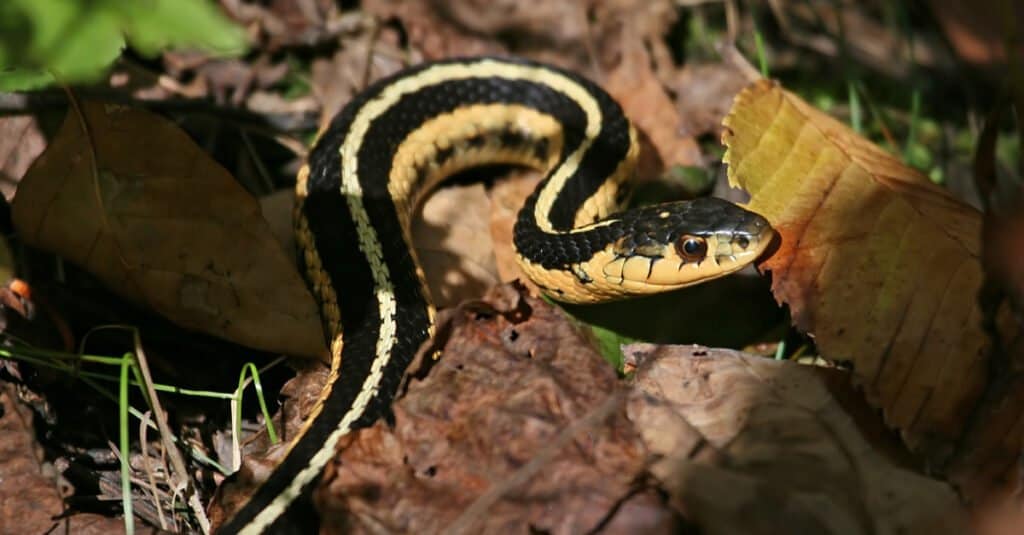
Similar in appearance to several types of garter snakes, the northern ribbon snake is common in Michigan.
©John Czenke/Shutterstock.com
The northern ribbon snake is quite common in Michigan. This snake looks very similar to several types of garter snakes and has similar striping patterns. But it has one distinctive feature which is a dead giveaway. The northern ribbon snake has black scales on the bottom part of the mouth, and the rest of the mouth is white. When you see black scales you can be sure it’s a northern ribbon snake and not a garter snake.
Northern ribbon snakes stay small and usually measure just a foot to a foot and a half in length. They eat mostly worms and small insects but they have been known to eat frogs and fish too. Chances are high that a northern ribbon snake will immediately flee if humans if come around so you will probably never get the chance to get close this tiny snake.
Queen Snake
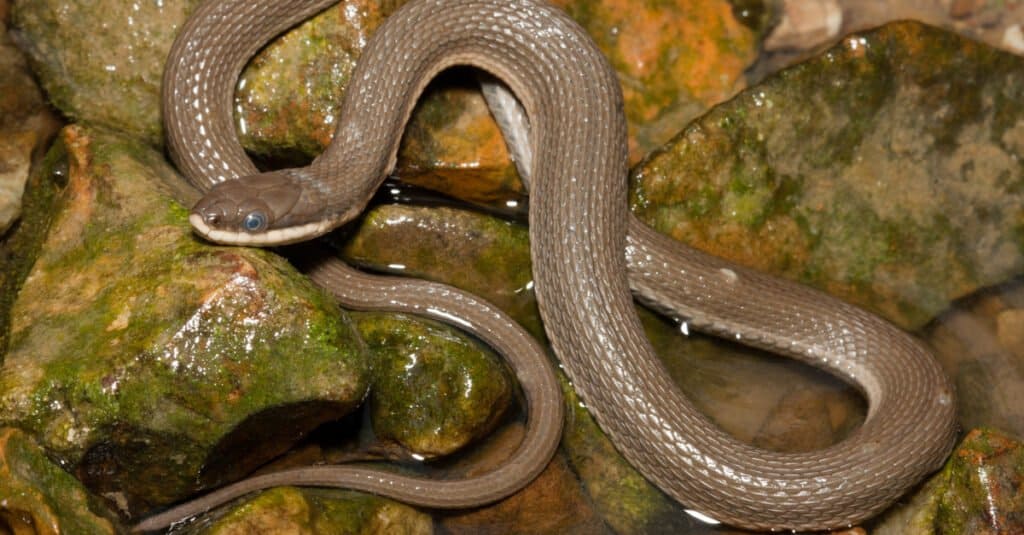
Queen snakes
live along streams and hunt mostly crayfish.
©Nathan A Shepard/Shutterstock.com
The queen snake is a water snake that likes a very specific type of habitat. Queen snakes prefer small rivers with rocky bottoms where they find lots of small fish, crayfish, and insects to eat. Crayfish are a particular treat for them but they will eat any small fish that they find in the river. The queen snake has a unique coloring of dull browns and yellows that allows them to blend in with their surroundings. They tend to be small and usually grow to a length between two and three feet. You may see a queen snake if you are fishing in a river but because they prefer small rivers even avid Michigan fishermen may never see one!
Eastern Milk Snake
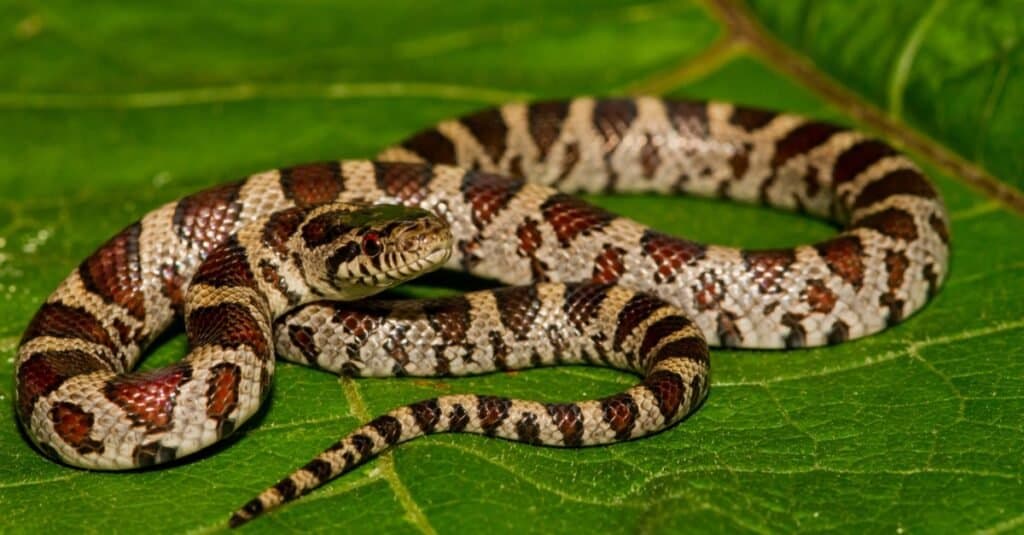
Milk snakes are found across Michigan and have been spotted in both the Upper and Lower Peninsulas.
©Jay Ondreicka/Shutterstock.com
Eastern milk snakes have very unique and beautiful coloration but you’ll probably never see one in person because they are nocturnal snakes who almost always only hunt at night. They eat insects and small rodents, so they prefer to be active when their prey is active which is at night. Even though they prefer to move in the dark these snakes have pale white or light yellow bodies with bright orange, light brown, or red markings. Those distinctive markings should make it harder for them to hunt at night because their light color is easily seen but they don’t seem to have any trouble maintaining their nocturnal lifestyle.
Milk snakes are found across Michigan and have been spotted in both the Upper and Lower Peninsulas.
Blue Racer Snake

While blue racers do inhabit Michigan, they are a tough-to-find breed, generally avoiding areas that humans frequent.
©Psychotic Nature/Shutterstock.com
Blue racers are another tough-to-find breed of snake, but if you ever do see one you’ll remember it. These snakes are long, many get to be around six feet long. And they have a unique light blue or blue-gray color that really stands out. But like other subspecies of racer snakes, they really don’t like being around humans and will quickly take off as soon as there is a human around. If you come across one in the wild you’ll quickly find out why they call these snakes racers. Often they will speed off at the very first sign of a human entering the area.
Venomous (Poisonous) Snakes in Michigan
There is only one type of venomous snake in Michigan, the eastern massasauga rattlesnake. This rattlesnake prefers to be in or near the water or in forests so unless you are a frequent hiker or spend a lot of time on the water you may never see one of these snakes.
Eastern Massasauga
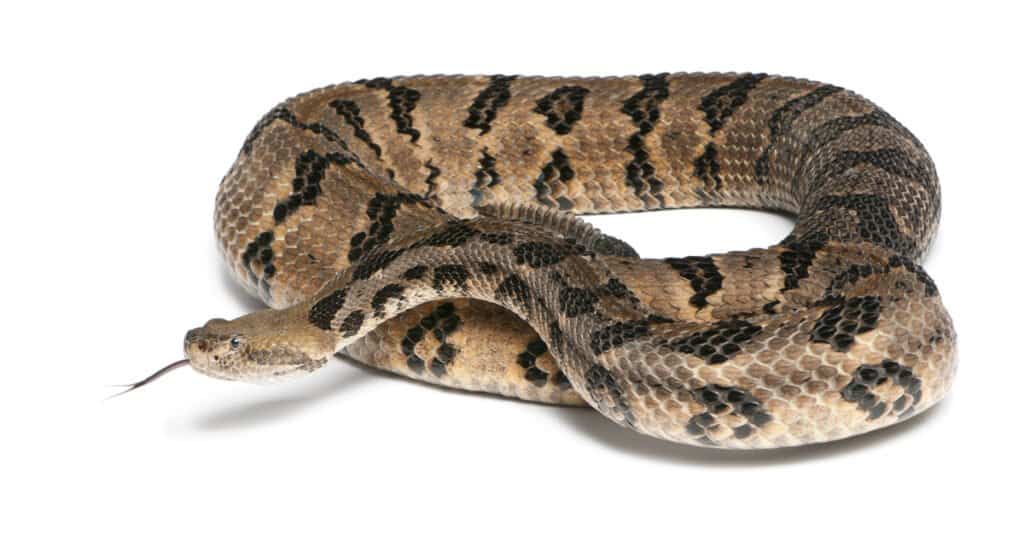
Eastern massasauga snakes are found throughout Michigan’s Lower Peninsula.
©fivespots/Shutterstock.com
Like most rattlesnakes, the eastern massasauga has a heavy body and is fairly wide, although the Eastern Massasauga is one of the smallest species of rattlesnake and usually doesn’t grow longer than five feet. It will use its rattle to let you know that you’re getting too close before it strikes. So if you hear a rattle you should back away slowly and not make any sudden movements. However, this rattlesnake will almost always flee instead of attacking. It is very shy and not aggressive unless you startle it or intentionally try to provoke it. If bitten by a massasauga, you’ll want to seek immediate medical attention, however.
Massasaugas are found throughout the Lower Peninsula of Michigan. So if you’re in the outdoors and concerned about poisonous snakes, this is the snake to commit to memory and avoid if you hear any rattling!
Water Snakes in Michigan
If you’re outdoors and enjoy water sports in Michigan, you may wonder which snakes are aquatic. Of Michigan’s 18 snakes, there are six that inhabit the water and marshlands to be aware of.
- Kirtland’s snake
- Northern water snake
- Copperbelly water snake
- Eastern massasauga rattlesnake
- Northern ribbon
- Queen Snake
We’ve described the Kirtland’s, eastern massasauga, northern ribbon, and queen snake above. In addition, you can be on the lookout for the following water snakes.
Copperbelly Water Snake
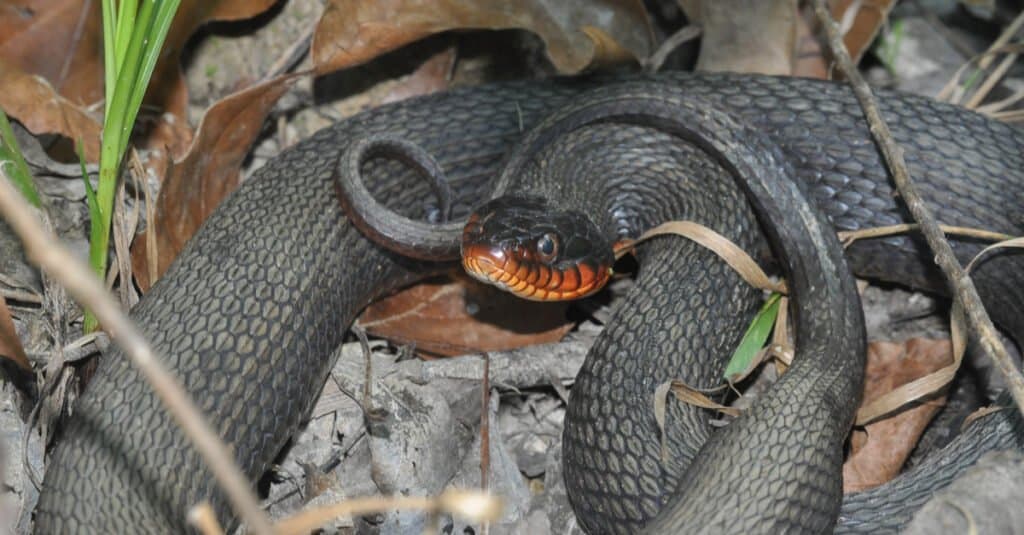
The copperbelly water snake has a distinctive red-orange coloring around its mouth.
©Mike Wilhelm/Shutterstock.com
Copperbelly water snakes have a distinctive red-orange marking around their mouth that helps them stand out when compared to other snake species. They can grow quite large, sometimes reaching nearly 5 feet in length. The snake is protected in Michigan as its population has been in decline. Today copperbelly snakes are found in isolated areas near the Indiana border.
Northern Water Snake
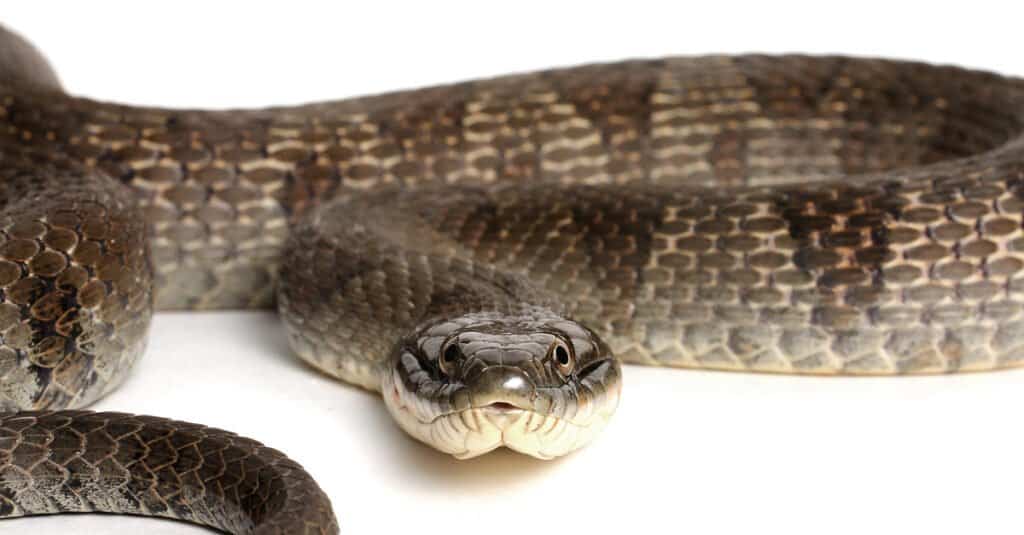
Northern water snakes are found in both the Upper and Lower Peninsula
©Michiel de Wit/Shutterstock.com
Northern water snakes have a much broader distribution in Michigan when compared to the copperbelly snake. These snakes are often confused with cottonmouth snakes, but are nonvenomous. They can reach up to about 5 feet in length and are often found basking in the sun near water sources
Safely Enjoy All That Michigan Has to Offer
Since all but one type of snake in Michigan is non-venomous and almost all of the snakes in Michigan including the eastern massasauga prefer to avoid people rather than interact with them no matter what outdoor activities you enjoy you should be able to enjoy them without worrying about any of the snakes in Michigan.
Summary of the 18 Snakes in Michigan
Below is a look back at the 18 snakes that inhabit the terrain and waterways of the great state of Michigan.
| Rank | Snake |
|---|---|
| 1 | Kirtland’s Snake |
| 2 | Blue Racer |
| 3 | Northern Ring-Necked Snake |
| 4 | Eastern Fox Snake |
| 5 | Eastern Hog-Nosed Snake |
| 6 | Eastern Milksnake |
| 7 | Smooth Green Snake |
| 8 | Eastern Milksnake |
| 9 | Copperbelly Water Snake |
| 10 | Northern Water Snake |
| 11 | Black Rat Snake |
| 12 | Gray Rat Snake |
| 13 | Queen Snake |
| 14 | Eastern Massasauga Rattlesnake |
| 15 | Brown Snake |
| 16 | Butler’s Garter Snake |
| 17 | Northern Ribbon Snake |
| 18 | Eastern Garter Snake |
Bonus: Are There Eastern Massasauga Rattlesnakes in Canada?

The range of eastern Massasauga rattlesnakes extends north of Michigan into areas of Ontario, Canada that border Lake Huron and Lake Erie.
©Vladislav T. Jirousek/Shutterstock.com
As Michigan borders three of the Great Lakes (Michigan, Huron, and Erie), and Ontario, Canada borders Michigan to the north, would it be safe to assume that these venomous snakes extend into Canada?
The answer is yes! Eastern Massasauga rattlesnakes have been found in the Wainfleet Bog on the northeast shores of Lake Erie, as well as the eastern side of Georgian Bay and the Bruce Peninsula of Lake Huron. This threatened species is the only venomous snake you’d find in those two Great Lakes, either in Canada or in Michigan.
The photo featured at the top of this post is © Psychotic Nature/Shutterstock.com
Discover the "Monster" Snake 5X Bigger than an Anaconda
Every day A-Z Animals sends out some of the most incredible facts in the world from our free newsletter. Want to discover the 10 most beautiful snakes in the world, a "snake island" where you're never more than 3 feet from danger, or a "monster" snake 5X larger than an anaconda? Then sign up right now and you'll start receiving our daily newsletter absolutely free.
Thank you for reading! Have some feedback for us? Contact the AZ Animals editorial team.







